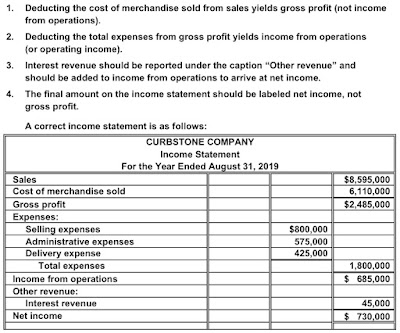United Rug Company is a small rug retailer owned and operated by Pat Kirwan. After the accounts have been adjusted on December 31, the following selected account balances were taken from the ledger:
Advertising Expense. . . . . . . . . . . . . . . . . . . . . . . . . . . . . . . . . . . . . . . . . . . . . . . $ 36,000 Depreciation Expense . . . . . . . . . . . . . . . . . . . . . . . . . . . . . . . . . . . . . . . . . . . . . 13,000 Freight In . . . . . . . . . . . . . . . . . . . . . . . . . . . . . . . . . . . . . . . . . . . . . . . . . . . . . . . . . 17,000 Merchandise Inventory, January 1 . . . . . . . . . . . . . . . . . . . . . . . . . . . . . . . . . . 375,000 Merchandise Inventory, December 31. . . . . . . . . . . . . . . . . . . . . . . . . . . . . . . 460,000 Miscellaneous Expense . . . . . . . . . . . . . . . . . . . . . . . . . . . . . . . . . . . . . . . . . . . . 9,000 Purchases. . . . . . . . . . . . . . . . . . . . . . . . . . . . . . . . . . . . . . . . . . . . . . . . . . . . . . . . . 1,760,000 Purchases Discounts . . . . . . . . . . . . . . . . . . . . . . . . . . . . . . . . . . . . . . . . . . . . . . . 35,000 Purchases Returns and Allowances . . . . . . . . . . . . . . . . . . . . . . . . . . . . . . . . . 45,000 Pat Kirwan, Drawing . . . . . . . . . . . . . . . . . . . . . . . . . . . . . . . . . . . . . . . . . . . . . . . 65,000 Salaries Expense . . . . . . . . . . . . . . . . . . . . . . . . . . . . . . . . . . . . . . . . . . . . . . . . . . 375,000 Sales . . . . . . . . . . . . . . . . . . . . . . . . . . . . . . . . . . . . . . . . . . . . . . . . . . . . . . . . . . . . . 2,220,000
The estimated cost of merchandise returns from December sales is $20,000. Journalize the closing entries on December 31.
Answer:
Dec. 31 Merchandise Inventory (December 31) 460,000
Estimated Returns Inventory 20,000
Sales 2,220,000
Purchases Discounts 35,000
Purchases Returns and Allowances 45,000
Merchandise Inventory (January 1) 375,000
Purchases 1,760,000
Freight In 17,000
Salaries Expense 375,000
Advertising Expense 36,000
Depreciation Expense 13,000
Miscellaneous Expense 9,000
Pat Kirwan, Capital 195,000
31 Pat Kirwan, Capital 65,000
Pat Kirwan, Drawing 65,000















